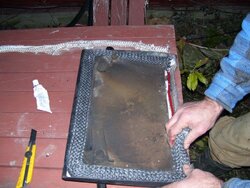Here's my setup:
Old BKK non-certified. 5' DSP to SS class A thru-the-wall and then up about 14'. 8" all the way.
Here's my issue:
When doing an overnight sized reload, I'll push the coals to the back near the air inlet, fill it up tight N/S with mixed hardwoods and set the dial so I can hear some, but not a ton of air coming in. Fans off.
Sometimes the stack temp will go nuclear and I'll end up with a "chimney cleaner". The DSP feels hotter than the stovetop...but not to the point where the class A adapter starts to glow. I don't have a probe thermometer, but this is hot enough to know that it's too hot. When this does happen I crank the dial all the way down and wait a few minutes till things cool off.
Never have this problem on a small reload...just the big overnighters. Stove top temp is usually 400-500 when this happens but sometime it will happen even lower. No correlation really.
I'm at a loss as to why this happens and it's frequent enough to be annoying. I have to watch the stove like a hawk for a couple hours after the reload.
My first thought was the thermostat was bad and/or the damper was sticking. The damper moves freely and adjusts to the temperature of the stove. No perceived issues. This makes sense that it leaves it open because the stove top temp is usually pretty low when this happens.
Bad / going bad gasket? Not sure…it can control it really well except for these big initial loads.
Too much draft...I don't have a damper?
Coals to close to the air inlet?
Something else?
Need some help from the experts.
Thanks.
Old BKK non-certified. 5' DSP to SS class A thru-the-wall and then up about 14'. 8" all the way.
Here's my issue:
When doing an overnight sized reload, I'll push the coals to the back near the air inlet, fill it up tight N/S with mixed hardwoods and set the dial so I can hear some, but not a ton of air coming in. Fans off.
Sometimes the stack temp will go nuclear and I'll end up with a "chimney cleaner". The DSP feels hotter than the stovetop...but not to the point where the class A adapter starts to glow. I don't have a probe thermometer, but this is hot enough to know that it's too hot. When this does happen I crank the dial all the way down and wait a few minutes till things cool off.
Never have this problem on a small reload...just the big overnighters. Stove top temp is usually 400-500 when this happens but sometime it will happen even lower. No correlation really.
I'm at a loss as to why this happens and it's frequent enough to be annoying. I have to watch the stove like a hawk for a couple hours after the reload.
My first thought was the thermostat was bad and/or the damper was sticking. The damper moves freely and adjusts to the temperature of the stove. No perceived issues. This makes sense that it leaves it open because the stove top temp is usually pretty low when this happens.
Bad / going bad gasket? Not sure…it can control it really well except for these big initial loads.
Too much draft...I don't have a damper?
Coals to close to the air inlet?
Something else?
Need some help from the experts.
Thanks.


